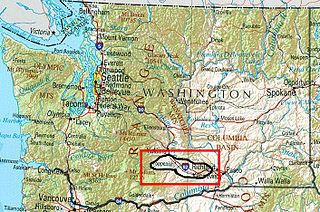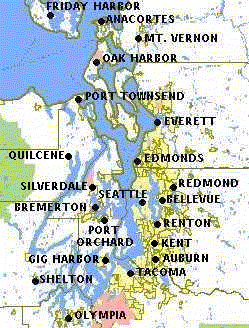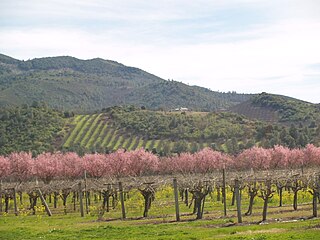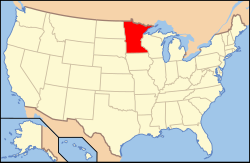
Illinois wine refers to any wine that is made from grapes grown in the U.S. state of Illinois. In 2006, Shawnee Hills, in southern Illinois, was named the state's first American Viticultural Area. As of 2008, there were 79 wineries in Illinois, utilizing approximately 1,100 acres (4.5 km2) of vines.

Washington wine is a wine produced from grape varieties grown in the U.S. state of Washington. Washington ranks second in the United States in the production of wine. By 2017, the state had over 55,000 acres (220 km2) of vineyards, a harvest of 229,000 short tons (208,000 t) of grapes, and exports going to over 40 countries around the world from the 940+ wineries located in the state. While there are some viticultural activities in the cooler, wetter western half of the state, the majority (99.9%) of wine grape production takes place in the shrub-steppe eastern half. The rain shadow of the Cascade Range leaves the Columbia River Basin with around 8 inches (200 mm) of annual rain fall, making irrigation and water rights of paramount interest to the Washington wine industry. Viticulture in the state is also influenced by long sunlight hours and consistent temperatures.
The state of Oregon in the United States has established an international reputation for its production of wine, ranking fourth in the country behind California, Washington, and New York. Oregon has several different growing regions within the state's borders that are well-suited to the cultivation of grapes; additional regions straddle the border between Oregon and the states of Washington and Idaho. Wine making dates back to pioneer times in the 1840s, with commercial production beginning in the 1960s.

The Yakima Valley AVA was the first American Viticultural Area established within Washington state, gaining the recognition in 1983. Part of the larger Columbia Valley AVA, Yakima Valley AVA is home to more than 18,000 acres (73 km2) of vineyards, giving the area the largest concentration of wineries and vineyards in the state. The most widely planted varietals in the area are Chardonnay, Riesling, Merlot, Cabernet Sauvignon, Pinot gris, and Syrah. Nearly 40% of Washington state yearly wine production is made from Yakima Valley grapes. In addition to grapes, the Yakima Valley is also home to several fruit orchards growing apples, cherries, nectarines, peaches, pears and plums. Around the town of Zillah, there is the Zillah Fruit Loop driving tour through the area's orchards and vineyards. The area is also home to nearly 80% of the US hop production.

The Puget Sound AVA is an American Viticultural Area in western Washington State. It is the only AVA in the state of Washington that is located west of the Cascade Mountains.

Sonoma County wine is wine made in Sonoma County, California, in the United States.

New Mexico has a long history of wine production, within American wine, especially along the Rio Grande, from its capital Santa Fe, the city of Albuquerque with its surrounding metropolitan area, and in valleys like the Mesilla and the Mimbres River valleys. In 1629, Franciscan friar García de Zúñiga and a Capuchín friar named Antonio de Arteaga planted the first wine grapes in Santa Fe de Nuevo México, in what would become the modern Middle Rio Grande Valley AVA. Today, wineries exist in the aforementioned Middle Rio Grande Valley, as well as the Mesilla Valley AVA and the Mimbres Valley AVA.

Massachusetts wine refers to wine made from grapes grown in the U.S. state of Massachusetts. Most of the wine grape vineyards and wineries in Massachusetts are located in the southern half of the state, within the boundaries of the Southeastern New England AVA. Although the coastal conditions moderate the cold climate, many wineries rely upon cold-hardy French hybrid varietals like Seyval, Vidal, and Marechal Foch. There are over 55 wineries in Massachusetts, and one designated American Viticultural Area, the Martha's Vineyard AVA, located entirely within the boundaries of the state.

Wisconsin wine refers to wine made from grapes grown in the U.S. state of Wisconsin. Wisconsin is part of the largest American Viticultural Area (AVA), the Upper Mississippi Valley AVA, which includes southwest Wisconsin, southeast Minnesota, northeast Iowa, and northwest Illinois. The state also has two smaller designated American Viticultural Areas, the Lake Wisconsin AVA and the Wisconsin Ledge AVA.

Arizona wine refers to wine made from grapes grown in the U.S. state of Arizona. There are three major regions of vineyards and wineries in Arizona:

Iowa wine refers to wine manufactured in the U.S. state of Iowa. Iowa presents many challenges to viticulture including very warm summer days that can promote fungal vine diseases, and extremely cold winter nights that can kill many varieties of grapevines. Most commercial viticulture in Iowa focuses on French hybrid and native American grape varieties, with relatively few plantings of Vitis vinifera grapes. Many Iowa wineries also import grapes and juice from other states and countries in order to produce wine varietals otherwise not possible due to Iowa's harsh winter months that will not permit such grapes to survive. Iowa is home to 100 commercial wineries and more than 300 vineyards covering 1,200+ acres. Northeastern Iowa is included in the Upper Mississippi Valley AVA while the western part of the state is in the new AVA designation named Loess Hills.

Mississippi wine refers to wine made from grapes grown in the U.S. state of Mississippi. The hot and humid climate of Mississippi makes it very difficult to cultivate vitis vinifera or French hybrid grapes. The three commercial wineries in Mississippi focus almost entirely on the Muscadine grape, a variety also used for non-alcoholic grape juices, jams, and jellies. Most of the Mississippi Delta AVA, a designated American Viticultural Area, lies within the state boundaries of Mississippi.

Nebraska wine is wine made from grapes grown in the U.S. state of Nebraska. Nebraska's oldest winery was founded in 1994, and about thirty-five commercial wineries operate across the state. Wine quality varies across the state, however several wineries have won Best of Show titles during the States first 25 years of commercial wine production. Five of those titles were won with wines made of the states #1 wine produced from the Variety Edelweiss. Other wins were made with a dry Brianna, Vignole and a Marechel Foch Rose' wine. The vast majority of these wineries are small and sell most of their wine to tourists who visit the winery in person. The University of Nebraska–Lincoln has a program in viticulture. There are no designated American Viticultural Areas in Nebraska.

Vermont wine refers to wine made from grapes grown in the U.S. state of Vermont. The first commercial winery in Vermont, Snow Farm Winery, opened in 1997. Vermont is a very cold climate for viticulture. Vermont wineries have focused on using cold-hardy French hybrid grapes, but have been experimenting with some Vitis vinifera varieties. Some Vermont wineries produce wine made from grapes grown in other states, especially New York.

The El Dorado AVA is an American Viticultural Area located in El Dorado County, California, United States. Wine grape growers in the region produce a large diversity of varietals, notable varietals are Zinfandel, Barbera, Cabernet Sauvignon, Merlot and Petite Sirah and there are significant plantings of Rhône varietals. Located in the foothills of the Sierra Nevada mountains, vineyards are found primarily at elevations between 600 feet (183 m) and 3,500 feet (1,067 m) above sea level and some of the historic and revered vineyards are planted above 2,000 feet (610 m) elevation. The region benefits from the cool breezes that come off the mountains and push hot air off the vines and down to the valley. The soils of the region are magma based with high levels of acidity.

Lake County wine is an appellation that designates wine made from grapes grown mostly in Lake County, California and located north of Napa County. Although each region within Lake County has unique viticultural attributes, all are influenced by Clear Lake, the largest inland body of water in California. Lake County enjoys a reputation for bright, concentrated red wines made from Cabernet Sauvignon, Syrah and Zinfandel, and fresh, aromatic whites made from Sauvignon Blanc. Cabernet Sauvignon has the most acreage, with Merlot a distant second.
The Grand River Valley AVA is an American Viticultural Area (AVA) spread across portions of the Lake, Geauga and Ashtabula counties of northeastern Ohio located 45 miles (72 km) east of Cleveland. The appellation was established on October 20, 1983, by the Bureau of Alcohol, Tobacco and Firearms (ATF) of the Department of Treasury and is the largest AVA in the state. The viticultural area lies entirely within the larger, multi-state Lake Erie AVA. The area is approximately 125,000 acres (195 sq mi) and the established inland boundary at any point is about 6 miles (10 km) inland from the shore east of Ohio Route 45 and 14 miles (23 km) from the shore west of Ohio Route 45. It stretches over the land within 2 miles (3 km), in any direction, of the Grand River from its origin near West Farmington to the point where it flows into Lake Erie encompassing 14 miles (23 km) inland from any point on its shoreline.

The Finger Lakes AVA is an American Viticultural Area located in Upstate New York, south of Lake Ontario. It was established in 1982 and encompasses the eleven Finger Lakes, but the area around Canandaigua, Keuka, Seneca, and Cayuga Lakes contain the vast majority of vineyard plantings in the AVA. Cayuga and Seneca Lakes each have their own American Viticultural Areas completely contained within the Finger Lakes AVA. The Finger Lakes AVA includes 11,000 acres (4,452 ha) of vineyards and is the largest wine-producing region in New York State.

The Upper Mississippi River Valley AVA is an American Viticultural Area covering 29,914 square miles located along the Upper Mississippi River and its tributaries in northwest Illinois, northeast Iowa, southeast Minnesota and southwest Wisconsin. Certified by the United States Department of the Treasury's Alcohol and Tobacco Tax and Trade Bureau on July 22, 2009, it is the largest AVA in the United States. The AVA encompasses an area 50 times larger than the Bordeaux wine regions of France.

The Minnesota Grape Growers Association (MGGA) was established in 1976 to further the art and science of growing grapes in cold climates. The association sponsors workshops, tours, tastings of locally produced wines and sponsors an important annual conference on cold climate viticulture.


















